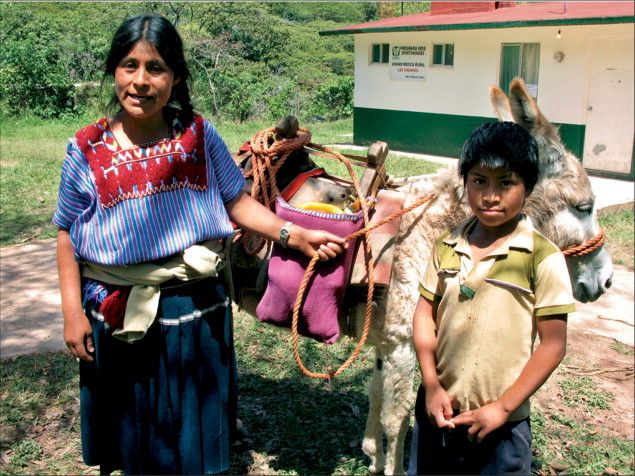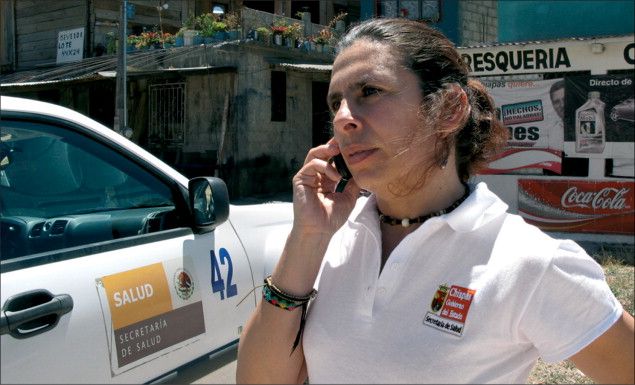Efforts to control tuberculosis and multidrug-resistant forms of the disease face extra hurdles in Mexico's poorer states. Samuel Loewenberg reports from Chiapas, southern Mexico. The village of Los Chorros lies in a lush valley reached by a dirt track at the end of a mountain road that winds past brick and wooden huts with thatched roofs, and terraced agricultural fields (see webvideo). At the top of a small hill is a yellow concrete building with a corrugated metal roof. This is the home of Marcela Gomez Vasquez, a 44-year-old mother of six from the Indigenous Mayan Tzotzil community.
Several years ago Marcela was diagnosed with tuberculosis. She was given a regimen of drugs to take at home. It worked, despite the fact that it was not the closely monitored regimen prescribed by WHO. But her children did not fare as well. Three of them developed growths on their bodies. The mass on the neck of her son Jose Guadalupe, 10 years old, was diagnosed as tuberculosis. The tests on his brothers were inconclusive. Marcela said that her children were never given prophylactic drugs or screening, which is why she believes they got sick. But once their problems developed, she made sure her children were treated. "I felt very bad. Sometimes children do not get better. If you do not know how to take care of the children they die. I know how to take care of them which is why I kept bringing them to the clinic", she said.
Despite Mexico's improvements in health at the national level, the most impoverished regions of the country still have alarming rates of tuberculosis, with more than 18 000 new cases in 2008. Of particular concern is the presence of the multidrug-resistant (MDR) strain of the disease. Chiapas, one of Mexico's poorest and most politically marginalised states, is one of the epicentres of the problem. Tuberculosis experts estimate that 14% of new cases of tuberculosis in Chiapas are MDR tuberculosis (government officials put it lower, but admit they have no comprehensive data). Everybody, though, agrees that the efforts to arrest the growth of tuberculosis fall far short of what is necessary to stop the problem.
The difficulties Mexico has in combating tuberculosis highlight the underlying problems that make tackling the global epidemic so complex. The problem is not only a medical one: although widely accepted treatment regimens have existed for years, the real obstacles are poverty, lack of political will, badly functioning health systems, and lack of money.
With major tuberculosis problems in China, Russia, and India, tuberculosis specialists say that not nearly enough attention is being paid to the problem. In response to the dramatic increase in drug-resistant cases, WHO revised its worldwide goal for treating MDR and extensively drug-resistant (XDR) tuberculosis by 2015 from 800 000 people to 1·6 million. XDR tuberculosis is especially worrisome: experts fear that some strains of XDR tuberculosis might in fact be totally drug resistant.
Globally, there are an estimated 440 000 new cases of drug-resistant tuberculosis a year. Nearly half of these cases are thought to be in China and India, according to WHO. Worldwide, 150 000 people died from drug-resistant tuberculosis in 2008. Yet despite the size and severity of the problem, global funding is still far below what is needed. Helping the 27 countries identified as having the worst MDR tuberculosis problems is estimated to cost US$16·2 billion by the Stop TB Partnership. Currently, the level of support, which includes aid and other loans, is less than $0·5 billion.
"TB has never been taken seriously enough by donors or the global health community writ large, it has just been languishing out there", said Donna Barry of Partners In Health, a medical advocacy and treatment organisation. Although China, India, and Russia have high-quality pilot programmes to treat MDR tuberculosis, there is as yet no federal commitment to scale them up to a national level. In neither these countries nor in most others with the highest burdens of HIV and tuberculosis co-infection have there been comprehensive surveillance studies, said Barry, which means it is impossible to accurately estimate the size of the MDR tuberculosis problem.
In the Chiapas region the problems with combating tuberculosis are impeded by poverty, poor housing, malnutrition, and a lack of medical resources. It is official policy in Mexico to follow WHO's directly observed therapy, short course (DOTS) regimen. But in Chiapas, as the case of Marcela Gomez Vasquez illustrates, it seems to fall short in practice.
"The state-run TB programme does not adhere to the basic principles of DOTS as defined by the WHO. There is not enough active case finding, a lack of political will, the supply of drugs is unreliable, and there is limited lab capacity", said Daniel Palazuelos, a doctor from Harvard Medical School and Partners in Health who has extensive experience in the Chiapas region. Other tuberculosis advocates noted that for half of 2009 there was no reliable store of tuberculosis drugs—apparently the result of an administrative mistake.
The rate of new patients with MDR tuberculosis in Chiapas is 14%, more than three times the official figure, according to Héctor Javier Sánchez-Pérez a widely published epidemiologist in the region from El Colegio De La Frontera Sur, Chiapas. The new chief tuberculosis for the region's public health system, Alied Bencomo, said that the official estimate is around 4%, but she acknowledged that the data are limited in scope, and did not discount the 14% estimate.
The presence of MDR tuberculosis is an indicator that the public health system does not work well, which governments are loath to admit, said Sánchez-Pérez. The federal government wants to keep the official rate of MDR tuberculosis low "because it is an indicator of the low level of human development", he said. "If the health system is not capable of making diagnoses and doing treatment, it is very likely that the rest of the health system is not functioning well either."
Sánchez-Pérez is the co-author of a study published in the International Journal of Epidemiology that analysed the record of the Los Altos region of Chiapas' tuberculosis programme. The study found that rates of mortality from tuberculosis have generally been twice as high as the national average, and of the 40 patients who died of pulmonary tuberculosis during the period of the study, more than 80% did not receive treatment.
Bencomo acknowledges that her antituberculosis programme does not have sufficient funding or resources. "Our programmes were created for countries with low resources. Our manual guides are for poor, Third World countries. That oppresses us because everything is created with the idea of how to implement it in a poor country", she told The Lancet.
The tuberculosis budget for her region of Chiapas is 1·5 million pesos ($121 400). That compares with 5 million pesos for the trachoma programme, which Bencomo also works on. Diagnosis, a major issue for tuberculosis control, is much lower than it should be, she said. "The problem with TB is that it is characterised as usually affecting Indigenous, poor people, so we continue to marginalise it, and therefore its victims do not have a voice. That is the big problem", said Bencomo. "Anyone can get it, like me, not just the poor. That is the message we need to get out there."
This sentiment was echoed by a 2009 report from the US Centers for Disease Control and Prevention. Although most tuberculosis occurs in poor populations in developing countries, the report makes the case that it is in the interest of the USA and other rich countries to act: "Unless the fundamental causes of MDR TB and XDR TB are addressed in the United States and internationally, the United States is likely to experience a growing number of cases of MDR TB and XDR TB that will be difficult, if not impossible, to treat or prevent."



